Fable Legends Early Preview: DirectX 12 Benchmark Analysis
by Ryan Smith, Ian Cutress & Daniel Williams on September 24, 2015 9:00 AM ESTDiscussing Percentiles and Minimum Frame Rates
Up until this point we have only discussed average frame rates, which is an easy number to generate from a benchmark run. Discussing minimum frame rates is a little tricky, because it could be argued that the time taken to render the worst frame should be the minimum. All it then takes is a bad GPU request (misaligned texture cache) which happens infrequently to provide skewed data. To this end, thanks to the logging functionality of the benchmark, we are able to report the frame rate profiles of each run and percentile numbers.
For the GTX 980 and AMD Fury X, we pulled out the 90th, 95th and 99th percentile data from the outputs, as well as plotting full graphs. For each of these data points, the 90th percentile should represent the frame rate (we’ll stick to reporting frame rates to simplify the matter) a game will achieve during 90% of the frames. Similar logic applies to the 95th and 99th percentile data, where these are closer to the absolute maximum but should be more consistent between runs.
This page (and the next) is going to be data heavy, but our analysis will discuss the effect of CPU scaling on percentile data on both GPUs in all three resolutions using all three CPUs. Starting with the GTX 980 Ti:
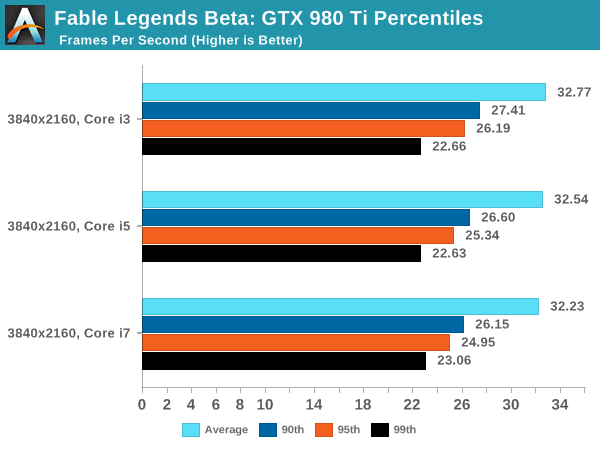
All three arrangements at 3840x2160 perform similarly, though there are slight regressions moving from the i3 to the i7 along most of the range, perhaps suggesting that having an excess of thread data has some issues. The Core i7 arrangement seems to have the upper hand at the low percentile (2%-4%) numbers as well.
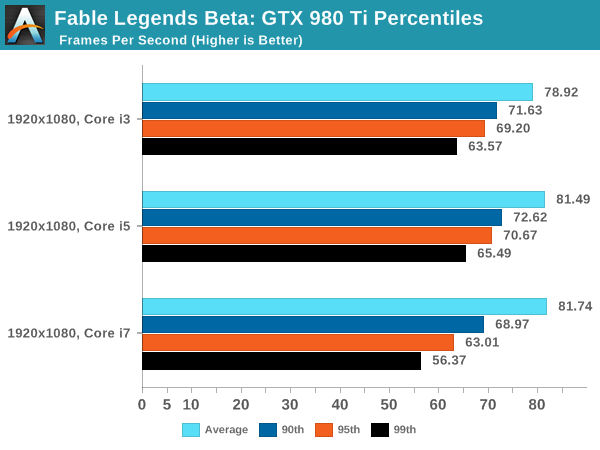
At 1080p, the Core i7 gives greater results when the frame rate is above the average and we see some scaling effects when the scenes are simple (giving high frame rates). But for whatever reason, when the going gets tough the i7 seems to bottom out as we go beyond the 80th percentile.
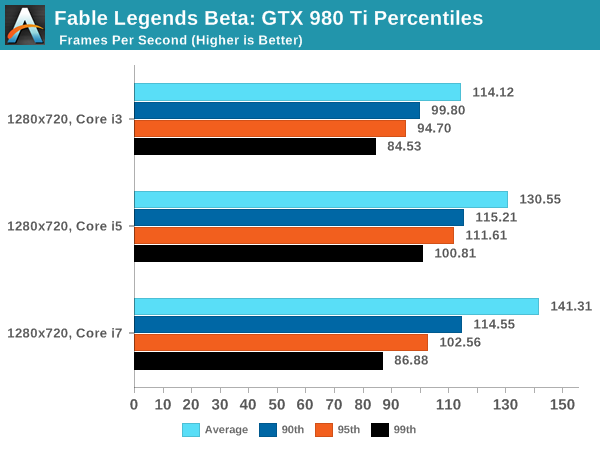
If we ever wanted to see a good representation of CPU scaling, the 720p graph is practically there – all except for the 85th percentile and up which makes the data points pulled out in this region perhaps unrepresentative of the whole. This issue might be the same issue when it comes to the 1080p results as well.


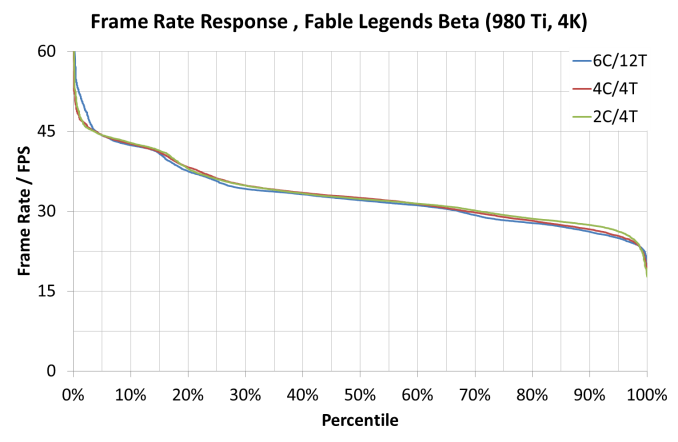
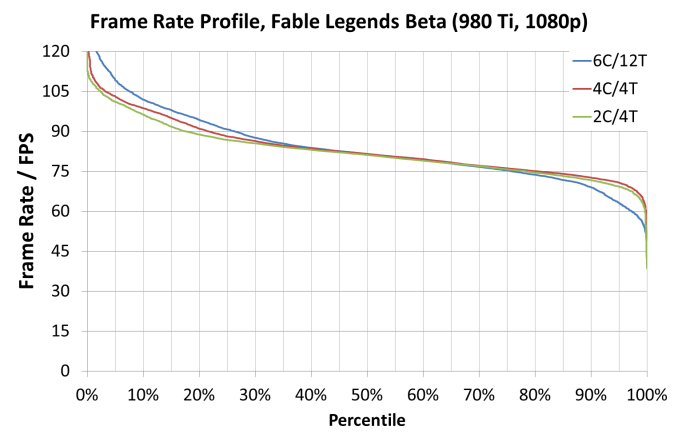
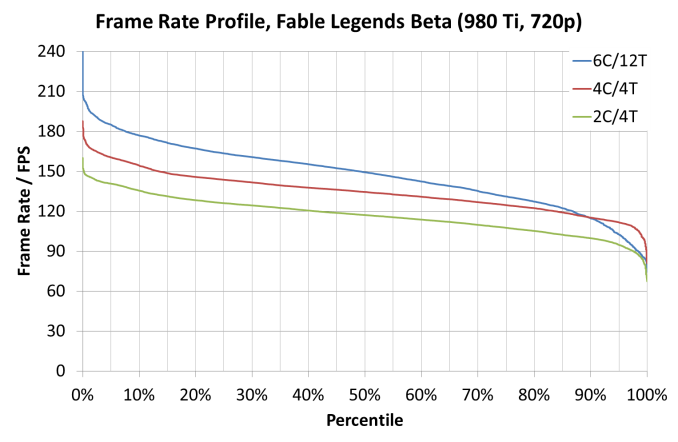








141 Comments
View All Comments
HotBBQ - Friday, September 25, 2015 - link
Please avoid using green and red together for plots. It's nigh impossible to distinguish if you are red-green colorblind (the most common).Crunchy005 - Friday, September 25, 2015 - link
So we have a 680, 970, 980ti. Why is there a 980 missing and no 700 series cards from nvidia? The 700s were the original cards to go against things like the 7970, 290, 290x. Would be nice see whether those cards are still relevant, although the lack of them showing in benchmarks says otherwise. Also the 980 missing is a bit concerning.Daniel Williams - Friday, September 25, 2015 - link
It's mostly time constraints that limit our GPU selection. So many GPU's with not so many hours in the day. In this case Ryan got told about this benchmark just two days before leaving for the Samsung SSD global summit and just had time to bench the cards and hand the numbers to the rest of us for the writeup.It surely would be great if we had time to test everything. :-)
Oxford Guy - Friday, September 25, 2015 - link
Didn't Ashes come out first?Daniel Williams - Friday, September 25, 2015 - link
Yes but our schedule didn't work out. We will likely look at it at a later time, closer to launch.Oxford Guy - Saturday, September 26, 2015 - link
So the benchmark that favors AMD is brushed to the side but this one fits right into the schedule.This is the sort of stuff that makes people wonder about this site's neutrality.
Brett Howse - Saturday, September 26, 2015 - link
I think you are fishing a bit here. We didn't even have a chance to test Ashes because of when it came out (right at Intel's Developer Forum) so how would we even know it favored AMD? Regardless, now that Daniel is hired on hopefully this will alleviate the backlog on things like this. Unfortunately we are a very small team so we can't test everything we would like to, but that doesn't mean we don't want to test it.Oxford Guy - Sunday, September 27, 2015 - link
Ashes came out before this benchmark, right? So, how does it make sense that this one was tested first? I guess you'd know by reading the ArsTechnica article that showed up to a 70% increase in performance for the 290X over DX11 as well as much better minimum frame rates.Ananke - Friday, September 25, 2015 - link
Hmm, this review is kinda pathetic...NVidia has NO async scheduler in the GPU, the scheduler is in the driver, aka it needs CPU cycles. Then, async processors are one per compute cluster instead one per compute unit, i.e. lesser number.So, once you run a Dx12 game with all AI inside, in a heavy scene it will be CPU constrained and the GPU driver will not have enough resource to schedule, and it will drop performance significantly. Unless, you somehow manage to prioritize the GPU driver, aka have dedicated CPU thread/core for it in the game engine...which is exactly what Dx12 was supposed to avoid - higher level of virtualization. That abstract layer of Dx11 is not there anymore.
So, yeah, NVidia is great in geometry calculations, it's always been, this review confirms it again.
The_Countess - Friday, September 25, 2015 - link
often the fury X GAINS FPS as the CPU speed goes down from i7 to i5 and i3.3 FPS gained in the ultra benchmark going from the i7 to the i3, and 7 in the low benchmark between the i7 and the i5.